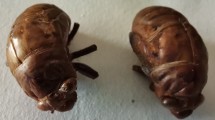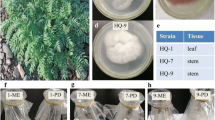Abstract
Auricularia auricula, one of the most important edible mushrooms, is affected heavily by Trichoderma. We collected the diseased samples from the main A. auricula cultivation regions to characterize the pathogen and study the effect of Trichoderma spp. on A. auricula species. We identified one Trichoderma species, T. pleuroticola, based on the internal transcribed spacer and morphology characteristics, and two types of A. auricula strains, Heiwei 15 (HW 15) and Hei 29 (H 29), were tested in this work. The growth rate of T. pleuroticola was 3.26–3.52 times higher than that of A. auricula and advantageously competed for living space and nutrients. In confrontation culture, T. pleuroticola completely inhibited the mycelium growth of A. auricula and grew on it, resulting in a diverse impact on HW 15 and H 29. In addition, T. pleuroticola can produce metabolites with antibacterial activity. The inhibition rate of volatile metabolites to H-29 and HW 15 was 13.46% and 10.44%, and the inhibition rate of nonvolatile metabolites to H-29 and HW 15 was 36.04% and 31.49%, respectively. Further analysis showed that these antifungal activities inhibiting Auricularia auricula growth were mainly attributed to the organic compounds from T. pleuroticola, nonanal, tyrosine, beta-sitosterol, and wortmannin. In short, T. pleuroticola was a highly pathogenic fungi in the production of A. auricula.
Graphical Abstract
T. pleuroticola can affect the normal growth of A. auricula hypha, and its metabolites also have inhibitory effects on A. auricula hypha.









Similar content being viewed by others
Data availability
The authors declare that the data supporting the findings of this study are available within the paper and its Supplementary Information files. Should any raw data files be needed in another format, they are available from the corresponding author upon reasonable request.
References
Hoyos-Carvajal L, Orduz S, Bissett J (2009) Genetic and metabolic biodiversity of Trichoderma from Colombia and adjacent neotropic regions. Fungal Genet Biol 462(9):615–631
Su DQ, Ding LJ, He S (2018) Marine-derived Trichoderma species as a promising source of bioactive secondary metabolites. Mini-Rev Med Chem 18(20):1702–1713
Reino JL, Guerrero RF, Hernandez-Galan R et al (2008) Secondary metabolites from species of the biocontrol agent Trichoderma. Phytochem Rev 7(1):89–123
Chen RG (2008) Isolation, identification and biocontrol mechanisms of antagonistic Trichoderma spp. Fu Jian Agricultural and Forestry University
Park MS, Bae KS, Yu SH (2006) The new species of Trichoderma associated with green mold of oyster mushroom cultivation in Korea. Mycobiology 34(3):111–113
Jayalal RGU, Adikaram NKB (2007) Influence of Trichoderma harzianum metabolites on the development of green mould disease in the oyster mushroom. Ceylon J Sci 36:53–60
Wang GZ, Cao XT, Ma XL et al (2016) Diversity and effect of Trichoderma spp. associated with green mold disease on Lentinula edodes in China. MicrobiologyOpen 5(4):709–718
Hatvani L, Kredics L, Allaga H et al (2017) First report of Trichoderma aggressivum F. aggressivum green mold on Agaricus bisporus in Europe. Plant Dis 101(6):1052–1053
Largeteau ML, Savoie JM (2010) Microbially induced diseases of Agaricus bisporus: biochemical mechanisms and impact on commercial mushroom production. Appl Microbiol Biotechnol 86(1):63–73
Obrien M, Kavanagh K, Grogan H (2017) Detection of Trichoderma aggressivum in bulk phase III substrate and the effect of T. aggressivum inoculum, supplementation and substrate-mixing on Agaricus bisporus yields. Eur J Plant Pathol 147(1):199–209
Kohl J, Kolnaar R, Ravensberg WJ (2019) Mode of action of microbial biological control agents against plant diseases: relevance beyond efficacy. Front Plant Science 10
Yan YH (2011) Rearch on Identification of Trichoderma of mushrooms and control of Trichoderma、Mycogone cercina. Fu Jian Agricultural and Forestry University
Kim CS, Park MS, Kim SC et al (2012) Identification of Trichoderma, a competitor of Shiitake mushroom (Lentinula edodes), and competition between Lentinula edodes and Trichoderma species in Korea. Plant Pathol J 28(2):137–148
Cao XT (2015) Preliminaly Study on Trichoderma Spp. Identification and incidence regularity associated with Lentinula edodes cultivation bag rot disease. Wuhan: Huazhong Agricultural University
Wu XP (2008) Identification pathogenic mechanism and control of Trichoderma spp. isolated from edible fungi. Fujian: Fujian Agricultural Forestry University
Hatvani L, Sabolic P, Kocsube S et al (2012) The first report on mushroom green mould disease in Croatia. Arh Hig Rada Toksikol 63(4):481–487
Muskhazli M, Faridah QZ, Salfarina R et al (2006) The evidence of N-glycan linked mannose in exochitinase 42kda, from Trichoderma harzianum BIO10671 glycosylation. Malays J Microbiol 2(2):37–41
Yang HT (2009) Classification and identification of Trichoderma. China Dadi Press, Beijing, p 389
Kumar S, Stecher G, Tamura K (2016) MEGA 7: molecular evolutionary genetics analysis version 7.0 for bigger datasets. Mol Biol Evol 33(7):1870–1874
Owaid MN, Alsaeedi SSS, Abed IA et al (2017) Antifungal activities of some Pleurotus species (higher Basidiomycetes). Walailak J Sci Tech 14(3):215–224
Ebadzadsahrai G, Keppler EAH, Soby SD et al (2020) Inhibition of fungal growth and induction of a novel volatilome in response to Chromobacterium vaccinii volatile organic compounds. Front Microbiol 11:1035–1035
Stracquadanio C, Quiles JM, Meca G et al (2020) Antifungal activity of bioactive metabolites produced by Trichoderma asperellum and Trichoderma atroviride in liquid medium. J Fungi 6(4):263
Li GL, Xu Y, Xing PJ et al (2019) Pathogenicity of Trichoderma spp. to Lentinula edodes and the inhibitory effects of biocontrol agents. Mol Plant Breed 17(19):6530–6534
Wang Y, Liu ZY, Feng Y et al (2021) Study on Trichoderma infection process in Lentinus edodes strain production. Seed 40(6):131–141
Marik T, Urban P, Tyagi C et al (2017) Diversity profile and dynamics of peptaibols produced by green mould Trichoderma species in interactions with their hosts Agaricus bisporus and Pleurotus ostreatus. Chem Biodivers 14(6):1–21
Innocenti G, Montanari M, Righini H et al (2019) Trichoderma species associated with green mould disease of Pleurotus ostreatus and their sensitivity to prochloraz. Plant Pathol 689(2):392–398
Bengtsson G, Hedlund K, Rundgren S (1991) Selective odor perception in the soil Collembolaonychiurus armatus. J Chem Ecol 17(11):2113–2125
Niu QH, Huang XW, Zhang L et al (2010) A Trojan horse mechanism of bacterial pathogenesis against nematodes. Proc Natl Acad Sci 107(38):16631–16636
Fernando WGD, Ramarathnam R, Krishnamoorthy AS et al (2005) Identification and use of potential bacterial organic antifungal volatiles in biocontrol. Soil Biol Biochem 37(5):955–964
Ando H, Hatanaka K, Ohata I et al (2012) Antifungal activities of volatile substances generated by yeast isolated from Iranian commercial cheese. Food Control 26(2):472–478
Ando H, Kurata A, Kishimoto N (2015) Antimicrobial properties and mechanism of volatile isoamyl acetate, a main flavour component of Japanese sake (Ginjo-Shu). J Appl Microbiol 118(4):873–880
Lee S, Yap M, Behringer G et al (2016) Volatile organic compounds emitted by Trichoderma species mediate plant growth. Fungal Biol Biotechnol 3:7
Zhao P (1997) Effects of amino acids on the growth and development of black fungus Mycelium. J Gansu Agric Univ 2:61–64
Brian PW, Curtis PJ, Hemming HG et al (1957) Wortmannin, an antibiotic produced by Penicillium wortmanni. Trans Br Mycol Soc 40(3):365–368
Ahluwalia V, Kumar J, Rana VS et al (2015) Comparative evaluation of two Trichoderma harzianum strains for major secondary metabolite production and antifungal activity natural product research. Nat Prod Res 29(10):914–920
Xuan QC, Huang R, Miao CP et al (2014) Secondary metabolites of endophytic fungus Trichoderma sp. YM 311505 of Azadirachta indica. Chem Nat Compd 50(1):139–141
Funding
This research was funded by the National Key Research and Development Projects during the 13th FiveYear Plan (2019YFC1606702) and by the Key Research and Development Projects of Shaanxi Province (2019NY-132; 2019NY-139; 2021NY-147). ZW acknowledges the support from Oakland University.
Author information
Authors and Affiliations
Contributions
BZ and ZW have designed this project and contributed to the main manuscript text. HD and QK conducted experiments and wrote the main manuscript text. XW, YL, HZ, YZ, XL, WW, and BBX have contributed to conducting the experiments, preparing figures, and writing. All authors reviewed the manuscript.
Corresponding authors
Ethics declarations
Conflict of interest
The authors declare no competing interests.
Additional information
Publisher’s Note
Springer Nature remains neutral with regard to jurisdictional claims in published maps and institutional affiliations.
Supplementary Information
Below is the link to the electronic supplementary material.
Rights and permissions
Springer Nature or its licensor (e.g. a society or other partner) holds exclusive rights to this article under a publishing agreement with the author(s) or other rightsholder(s); author self-archiving of the accepted manuscript version of this article is solely governed by the terms of such publishing agreement and applicable law.
About this article
Cite this article
Dang, H., Kong, Q., Winchester, W. et al. Isolation, identification, and pathogenic effects of Trichoderma spp. from Auricularia auricula. Adv Compos Hybrid Mater 6, 96 (2023). https://doi.org/10.1007/s42114-022-00588-y
Accepted:
Published:
DOI: https://doi.org/10.1007/s42114-022-00588-y




